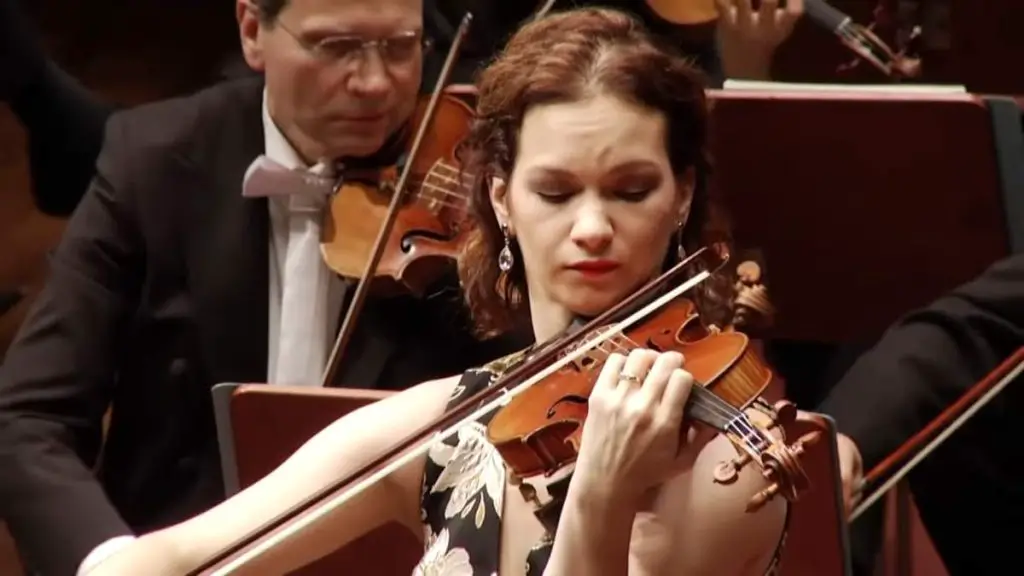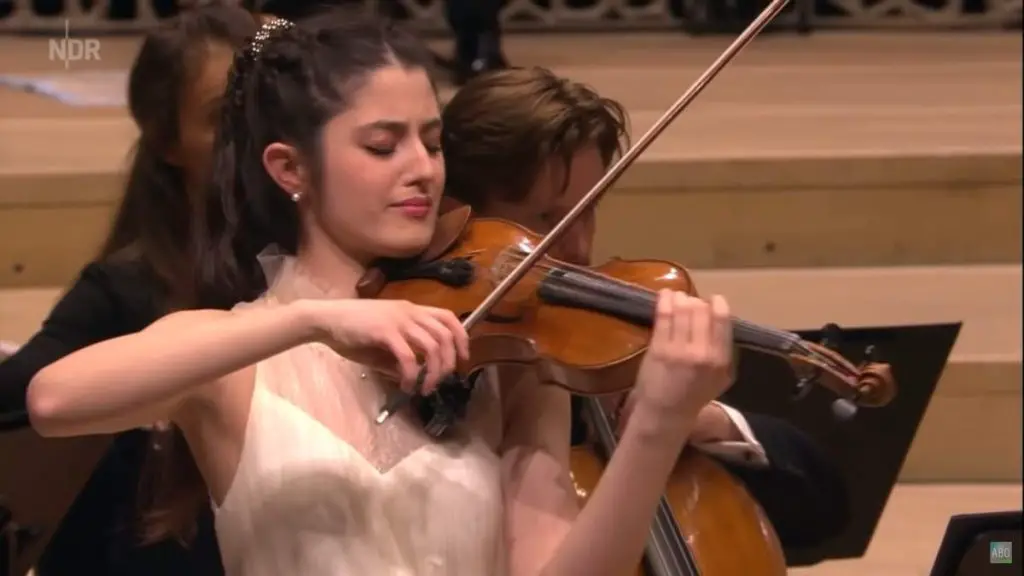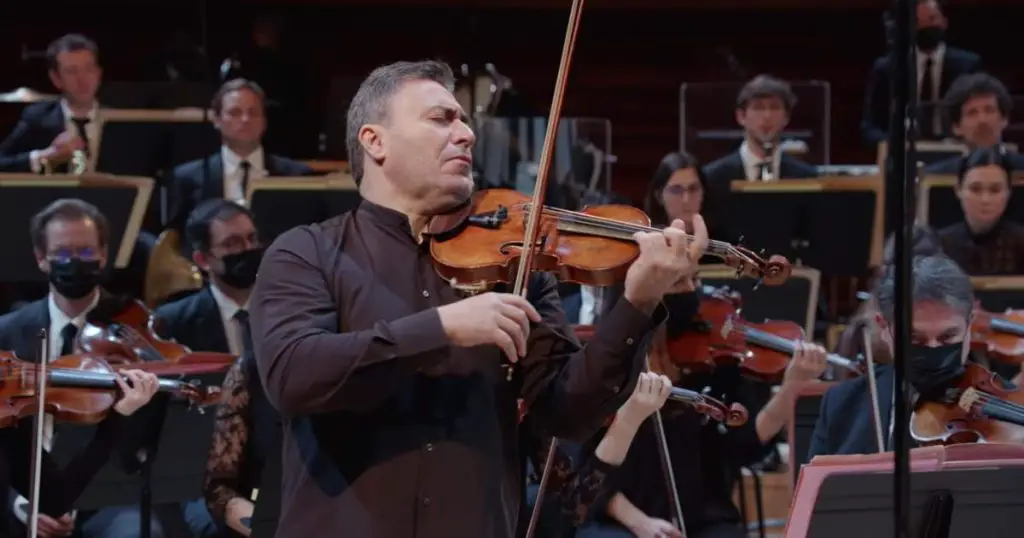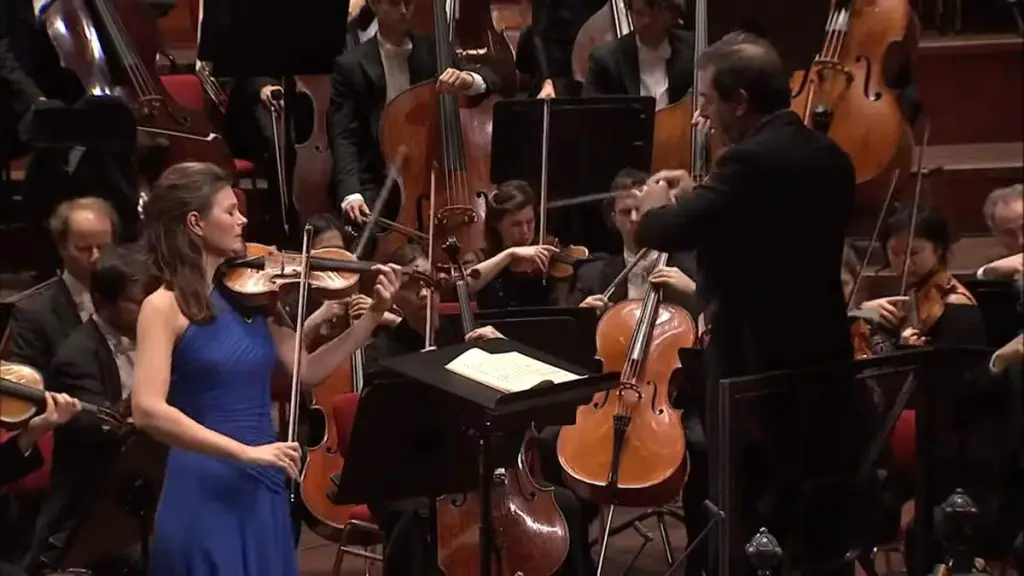Accompanied by the Orchestre La Fosse Ô Lyon, the French violinist Lucie Cointet performs German Romantic era composer Max Bruch’s Violin Concerto No. 1 in G minor, Op. 26, one of the most popular violin concertos in the classical repertoire. Conductor: Samuel Fernandez.
Max Bruch’s Violin Concerto No. 1
Max Bruch’s Violin Concerto No. 1 in G minor, Op. 26, is a cornerstone of the violin repertoire, cherished for its lyrical depth and emotional expressiveness. Composed in 1866, it quickly became one of Bruch’s most famous compositions, reflecting his mastery in marrying the violin’s capabilities with a rich orchestral tapestry. This piece is often noted for its blend of Romantic fervor and classical structural principles, which together create a work of enduring popularity and appeal.
Bruch, a German composer who lived from 1838 to 1920, was deeply influenced by the Romantic era’s emphasis on personal expression and emotional depth. His Violin Concerto No. 1 showcases these qualities, embodying a passionate, almost narrative-like quality that engages both the soloist and the audience in a musical journey. The concerto is characterized by its lush melodies and dramatic contrasts, featuring the violin in a profoundly expressive role. Bruch’s skill in orchestration is evident in the way he balances the solo violin with the orchestral parts, allowing the two elements to complement and enhance each other without overshadowing.
The concerto’s enduring appeal can be attributed to its captivating melodies and the technical challenges it presents to the violinist. These elements demand a high level of virtuosity and emotional depth from the performer, making it a favorite amongst violinists and a staple in concert programs worldwide. Its popularity also stems from its accessibility to audiences; the music, while complex and sophisticated, is immediately engaging and resonant on an emotional level.
The reception of the concerto since its premiere has been overwhelmingly positive, securing Bruch’s reputation as a significant composer, particularly in the realm of violin music. It has been recorded and performed by numerous celebrated violinists over the years, each bringing their unique interpretation to its richly woven tapestry of themes and motifs.
Movements
1. Vorspiel: Allegro moderato
The first movement of Max Bruch’s Violin Concerto No. 1 in G minor, Op. 26, is a compelling and expressive piece that sets the tone for the entire concerto. This movement, marked “Vorspiel: Allegro moderato” (Prelude: Moderately fast), is distinguished by its dramatic intensity and lyrical beauty.
One of the unique aspects of this movement is its structure. Unlike many traditional concertos of the Romantic era, which typically start with an orchestral exposition, Bruch begins with a brief but poignant orchestral introduction that quickly leads into the violin’s entry. This approach creates an immediate connection between the soloist and the orchestra, setting the stage for a dialogue that continues throughout the piece.
The violin enters with a passionate and expressive theme that is both lyrical and demanding. This theme showcases the violin’s ability to convey deep emotion, and it requires a high degree of technical skill and expressiveness from the soloist. The violin part is characterized by its wide range of dynamics, rich tonal color, and the use of various bowing techniques to create a sense of drama and intensity.
As the movement progresses, the interplay between the solo violin and the orchestra becomes more intricate. The orchestral accompaniment provides a lush and harmonious backdrop to the violin’s melodic lines, while also introducing thematic material of its own. This back-and-forth creates a rich tapestry of sound, with the violin often soaring above the orchestral texture.
The development section of the movement further explores the themes introduced earlier, with the violin and orchestra engaging in a more intense and complex exchange. The music builds to a climax, showcasing Bruch’s skill in creating dramatic tension and release.
The movement concludes with a recapitulation of the main themes, allowing the violin to revisit the initial melody with renewed depth and perspective. The movement ends with a sense of resolution, yet leaves the listener anticipating what is to come in the subsequent movements.
2. Adagio
The second movement of Max Bruch’s Violin Concerto No. 1 in G minor, Op. 26, is a profound and deeply moving piece, often regarded as the emotional heart of the concerto. This movement, marked “Adagio,” is a beautiful demonstration of lyrical expressiveness and intimate musical dialogue between the solo violin and the orchestra.
Characterized by its slow tempo and reflective mood, the Adagio opens with a gentle orchestral introduction, setting a tranquil and somewhat melancholic atmosphere. This introduction paves the way for the solo violin’s entrance, which is one of the most tender and poignant moments in the violin repertoire.
The violin part in this movement is notable for its expressive, singing quality. The melody, played on the violin, is both simple and profound, conveying a sense of longing and deep emotion. The soloist must bring a high level of expressivity to the performance, using subtle nuances in dynamics and phrasing to bring out the lyrical beauty of the music.
Throughout the movement, the orchestra supports and interacts with the solo violin, providing a lush harmonic background that enhances the solo line. The orchestration is delicate and restrained, allowing the violin’s melody to take center stage. The interplay between the soloist and the orchestra is intimate and conversational, with each echoing and responding to the other’s musical ideas.
As the movement unfolds, the music builds in intensity but always maintains a sense of introspection and tenderness. The climax of the movement is reached with a passionate and heartfelt expression of the main theme by the solo violin before the music gradually subsides into a serene and peaceful conclusion.
The Adagio of Bruch’s Violin Concerto No. 1 is celebrated for its emotional depth and melodic beauty. It requires a delicate balance from the soloist, who must navigate the technical challenges of the violin part while conveying the profound emotional content of the music. The movement is a favorite among both performers and audiences for its ability to evoke deep emotional responses, and it stands as a testament to Bruch’s skill as a composer of lyrical, Romantic music.
3. Finale. Allegro energico
The third movement of Max Bruch’s Violin Concerto No. 1 in G minor, Op. 26, serves as a vibrant and spirited finale to the concerto. Marked “Finale: Allegro energico,” this movement is characterized by its rhythmic drive, technical virtuosity, and a return to the passionate intensity that opened the concerto.
In contrast to the introspective and lyrical second movement, the finale bursts forth with energy and dynamism. The movement opens with a rousing orchestral introduction, setting a lively and brisk tempo. This introduction builds up momentum, leading into the entry of the solo violin.
The violin part in this movement is demanding and exhilarating, showcasing the instrument’s full range of technical capabilities. The soloist is required to perform a variety of challenging techniques, including rapid-scale passages, double stops, and intricate bowing patterns. These technical demands are not just for show; they serve to enhance the emotional and dramatic impact of the music.
One of the key features of this movement is its rhythmic vitality. Bruch employs driving rhythms and energetic motifs that propel the music forward. The interaction between the solo violin and the orchestra is particularly engaging, with the orchestra providing a robust and rhythmic foundation for the violin’s acrobatic displays.
As the movement progresses, the music becomes increasingly intense, with the soloist and orchestra engaging in a thrilling musical dialogue. The violin part soars above the orchestral texture, sometimes in a commanding and assertive manner, at other times with a more playful and capricious tone.
The finale reaches its climax with a series of brilliant and energetic passages for the violin, culminating in a virtuosic cadenza (a solo passage where the soloist showcases their skill). This cadenza is a focal point of the movement, allowing the soloist to display their technical prowess and interpretive abilities.
The movement concludes with a return to the main themes and a final, triumphant orchestral statement, bringing the concerto to a rousing and satisfying close.
Sources
- Violin Concerto No. 1 (Bruch) on Wikipedia
- Violin Concerto No. 1, Op.26 (Bruch, Max) on the International Music Score Library Project website




Hello,
Thanks for mentioning our orchestra La Fosse Ô Lyon and our dear soloist Lucie Cointet. Anyway, the conductor is Samuel Fernandez, not Manfred Honeck. Would you mind correcting this ?
Kind regards,
Raynald Cany
Fixed, many thanks!